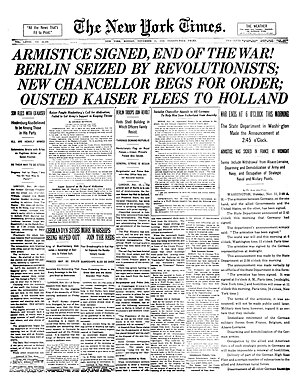
Back يوم الهدنة Arabic Ден на примирието Bulgarian যুদ্ধবিরতি দিবস Bengali/Bangla Dia de l'Armistici Catalan Ημέρα Ανακωχής Greek Jour de l'Armistice French יום שביתת הנשק HE Հաշտության օր Armenian 第一次世界大戦休戦記念日 Japanese Ден на примирјето Macedonian
| Armistice Day | |
|---|---|
 Front page of The New York Times on Armistice Day, 11 November 1918 | |
| Observed by | Australia, Belgium, Canada, France, New Zealand, Romania, Serbia, United Kingdom and many other countries |
| Significance | Commemoration of the signing of the Armistice between the Allied Powers and the Central Powers effectively ending all military operations and hostilities in all theatres and fronts of World War I at Compiègne, France |
| Date | 11 November |
| Next time | 11 November 2025 |
| Frequency | Annual |
| First time | World's first official observance at Buckingham Palace, London, on 11 November 1919 |
| Related to | Coincides with Remembrance Day and Veterans Day; and related to Remembrance Sunday |

Armistice Day, later known as Remembrance Day in the Commonwealth and Veterans Day in the United States, is commemorated every year on 11 November to mark the armistice signed between the Allies of World War I and Germany at Compiègne, France, at 5:45 am[1] for the cessation of hostilities on the Western Front of World War I, which took effect at 11:00 am—the "eleventh hour of the eleventh day of the eleventh month" of 1918—although, according to Thomas R. Gowenlock, an intelligence officer with the U.S. First Division, shelling from both sides continued for the rest of the day, ending only at nightfall.[2][3] The armistice initially expired after a period of 36 days and had to be extended several times. A formal peace agreement was reached only when the Treaty of Versailles was signed the following year.[4]
The date is a national holiday in France, and was declared a national holiday in many Allies of World War I nations, several of whom have since changed the name of the holiday from Armistice Day to either Remembrance Day in the Commonwealth of Nations, or Veterans Day in the United States.[5] In some countries Armistice Day coincides with other public holidays.
- ^ "Armistice: The End of World War I, 1918". EyeWitness to History. Archived from the original on 26 November 2018. Retrieved 26 November 2018.
- ^ "How World War I Soldiers Celebrated the Armistice". 10 November 2016.
- ^ Gowenlock, Thomas (1937). Soldiers of Darkness. Doubleday, Doran & Co. OCLC 1827765.
- ^ Shushkewich, Val (2005). The real Winnie : a one-of-a-kind bear. Natural Heritage Books. p. 42. ISBN 978-1554883509.
- ^ Osborne, Samuel (11 November 2015). "Armistice Day, Remembrance Day and Veterans Day – what's the difference?". The Independent. Archived from the original on 18 November 2018. Retrieved 18 November 2018.